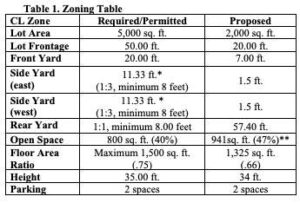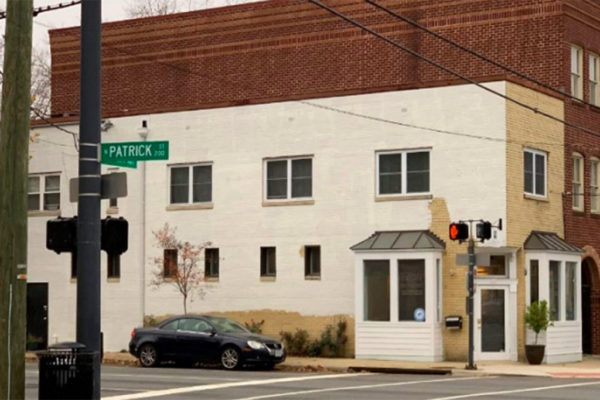(Updated 5/20) A stretch of vacant land and parking lots in the Parker-Gray could soon become a five-story, multi-family residential development with a redesign meant to evoke the neighborhood’s unique heritage.
The development is headed to its second Board of Architectural Review (BAR) meeting tomorrow (Wednesday). The building underwent a slight redesign after a February meeting when the board scolded the architect for trying to make an industrial waterfront-style building in lieu of respecting the historically Black neighborhood’s own unique — and distinctly not Old Town — aesthetics and style.
“The character of the three-story portion of the building has been modified to be more reminiscent of the historic Parker Gray school… than the industrial buildings more commonly found at the waterfront,” a city staff report noted.
The building went through a few more visual updates to bring it more in-line with other buildings in the neighborhood, like replacing glass balconies with black iron-railing.
The new building would be immediately adjacent to the Holiday Inn Express currently under development.
“Staff recommends that the BAR endorse the proposed design direction for the project,” staff said in the report, “shifting the tallest part of the building towards the east side of the site and revising the architectural character to make it more compatible with the immediate neighborhood.”
Images via City of Alexandria
In what is possibly the ultimate example of making use of the city’s land scarcity, a new application coming up at the Monday (April 12) Board of Zoning Appeals meeting seeks to turn a Parker-Gray alleyway into a new single-family home.
The 2,000 square foot lot at 1117 Queen Street is strip of gravel between two other homes mainly used for street parking.
It isn’t the first time the property has been a home, however. According to the staff report, records show a home existing on the property in 1877, though the original date of construction is unknown. The home was demolished in 1985.
 A staff report on the proposal shows that the property meets almost none of the city’s minimum zoning requirements, but the staff report noted that in the broader context of the street those zoning requirements hold little water.
A staff report on the proposal shows that the property meets almost none of the city’s minimum zoning requirements, but the staff report noted that in the broader context of the street those zoning requirements hold little water.
“The request is a reasonable deviation from the provisions of the CL zone of the Zoning Ordinance,” staff said. “The minimum lot area and lot width, front setback and side yard setback requirements do not reflect the existing historic development character of this neighborhood, nor do they reflect the building that was historically on this property for more than a century. The minimum lot area and lot width, and side yard setbacks result in this lot being unbuildable without variances.”
The staff report noted that no other residential lots on the block meet the minimum lot area either, with some of the lots being less than 1,9000 total square feet.
Ultimately, staff recommend approval of the new development.
Photo via Google Maps
A Parker-Gray business could have to un-paint their property after an unauthorized paint-job over a building’s historically significant architecture.
A commercial building at 1000 Queen Street may have looked significantly whiter late last year after the applicant, Anchor Property Services, painted over the existing yellow-brick exterior with a white coat of paint.
The problem? The property is in the Parker-Gray Historic District and the building is one of the few remaining examples of yellow brick architecture in the area. Staff is recommending that an application for a certificate of appropriateness filed after the building owners were hit with a violation be denied at tonight’s (Thursday) Board of Architectural Review meeting.
“Historically, most property owners avoided painting brick because painting it was expensive, and the use of brick was a clear sign that the building was higher quality and built of a more expensive material than frame construction with wood siding,” staff said in a report. “In the Parker-Gray District most, if not all of the painted brick buildings, likely date from the time before the district was created in 1984. Additionally, there are very few yellow brick buildings located within either historic district. These buildings should remain unpainted to preserve the architectural integrity of the property.”
The building was constructed in 1948 as a store and office building, and staff’s report noted that the design reflects a commercial style that was common in the early-to-mid 20th century. While there have been a few minot alterations, like replacement of the original windows, the report said the building has retained most of its original features.
“The BAR has always been are very concerned about the painting of previously unpainted masonry and the zoning ordinance specifically prohibits this without BAR approval,” staff said in the report. “This is in part because painting unpainted masonry significantly alters the character and material of a building.”
The report noted that 1000 Queen Street is currently one of three violations being reviewed for unauthorized painting over unpainted masonry. Staff said that in similar circumstances, the paint was successfully removed with a biodegradable, water-based painted remover without damaging the masonry underneath.


